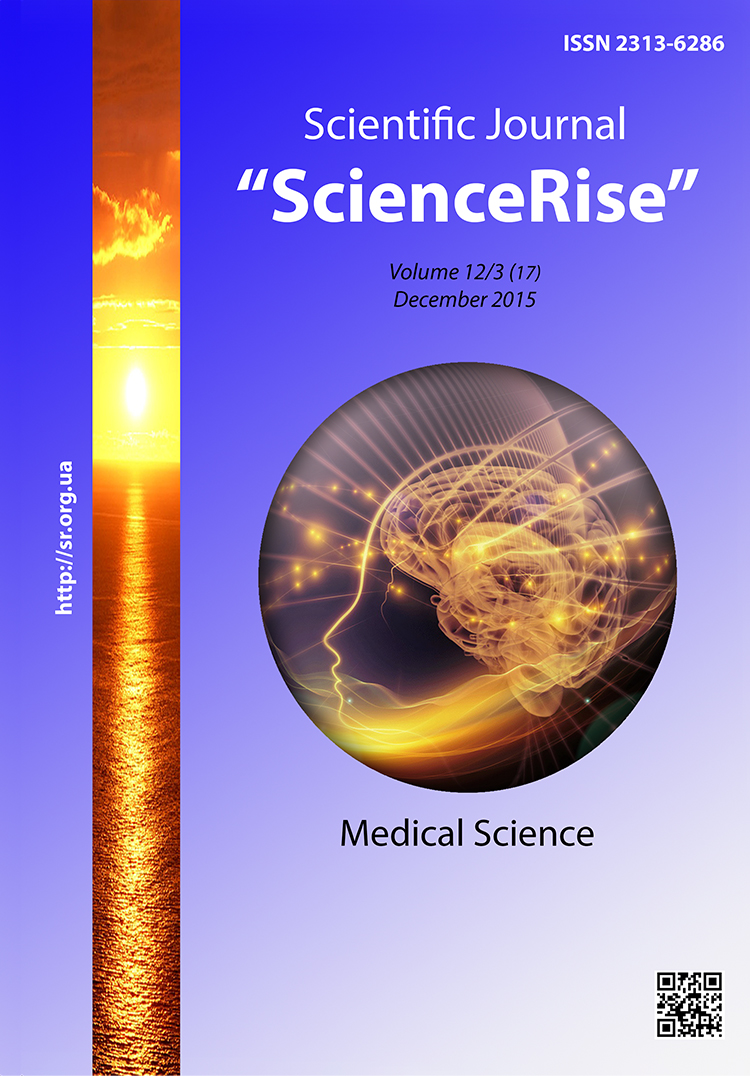Level of TOLL-like receptors (TLR-4) in plasma – marker of hyperalgesia in the early postoperative period
DOI:
https://doi.org/10.15587/2313-8416.2015.57080Keywords:
hyperalgesia, toll-like receptors, postoperative period, childrenAbstract
It is well-known that at activation of TLR4 monocytes/macrophages takes place an escape of opioid peptides from inflammatory cytokines that is one of the more important mechanisms of antinociceptive system.
Materials and method. In 24 children who underwent operations of abdominal cavity tumors were done 20 measurements of the mechanical pain threshold using the set of 10 von Frey monofilaments (VFM). The pain threshold was measured on the surface around postsurgical wound. The content of tall-like receptors TLR-4 in the blood serum was detected by immunoenzyme method using “Human TLR4 ELISA Kit” (NeoBiolab, USA) set.
Results. The use of big doses of fentanyl (2800 - 6200 mcg/day) for anesthesia in early postoperative period in children may lead to hyperalgesia. Hyperalgesia in an early postoperative period is characterized with an increase of TLR4 in blood (at 3 day the level of TLR4 was 14,2±2,4, ng/ml, at 5 day - 12,1±1,6, ng/ml that is significantly higher than preoperative its level - 5,2±1,4, ng/ml).
Conclusions. The big doses of fentanyl were associated with lowered pain threshold and development of hyperalgesia that was represented with an increase of TLR4 level in blood of children who underwent operations of abdominal cavity tumors. An analysis of graphic dependency of distribution of outgoing remains from prognosticated values and its diagram reproduction testified that it have chaotic character of disposition on the plane and there was not observed any regularity in its behavior that testifies an absence of correlations between it
References
Abaturov, A. E., Volosovets, A. P., Yulish, E. I. (2012). The role of Toll-like receptors in recognize pathogen-associated molecular patterns of infectious pathogens and the development of inflammations. Part 4: The intracellular signaling pathways TLR. Child Health, 8 (43), 163–167.
Abaturov, A. E., Volosovets, A. P., Yulish, E. I. (2012). The role of Toll-like receptors in recognize pathogen-associated molecular patterns of infectious pathogens and the development of inflammations. Part 1: Family TLR. Child Health, 5 (40), 116–121.
Abaturov, A. E., Volosovets, A. P., Yulish, E. I. (2012). The role of Toll-like receptors in recognize pathogen-associated molecular patterns of infectious pathogens and the development of inflammations. Part 2. Ligands TLR. Child Health, 6 (41), 213–219.
Abaturov, A. E., Volosovets, A. P., Yulish, E. I. (2012). The role of Toll-like receptors in r recognize pathogen-associated molecular patterns of infectious pathogens and the development of inflammations. Part 3 Rekognitsiya ligands TLR. Child Health, 7 (42), 157–164.
Sauer, R.-S., Hackel, D., Morschel, L., Sahlbach, H., Wang, Y., Mousa, S. A. et. al. (2014). Toll like receptor (TLR)-4 as a regulator of peripheral endogenous opioid-mediated analgesia in inflammation. Mol Pain, 10 (10), 1–15. doi: 10.1186/1744-8069-10-10
Liu, T., Gao, Y.-J., Ji, R.-R. (2012). Emerging role of Toll-like receptors in the control of pain and itch. Neuroscience Bulletin, 28 (2), 131–144. doi: 10.1007/s12264-012-1219-5
Kuchin, Y. L., Glumcher, F. S., Belka, K. Y. (2012). Opіoid-induced hypealgesia during analgosedation in patients with cerebral injure. Bіl, znebolyuvannya that іntensivna terapіya, 1D, 254–257.
Kuchin, Y. L. (2013). Stress-іnduced hyperalgesia in patіens with cerebral injure. Bіl, znebolyuvannya that іntensivna terapіya, 2 (D), 262–266.
Angst, M. S., Clark, J. D. (2006). Opioid-induced Hyperalgesia. Anesthesiology, 104 (3), 570–587. doi: 10.1097/00000542-200603000-00025
Celerier, E., Gonzalez, J. R., Maldonado, R. et. al. (2006). Opioid-induced hyperalgesia in a murine model of postoperative pain: role of nitric oxide generated from the inducible nitric oxide synthase. Anesthesiology, 104 (3), 546–555. doi: 10.1097/00000542-200603000-00023
Downloads
Published
Issue
Section
License
Copyright (c) 2015 Дмитро Валерійович Дмитрієв, Юрій Юрійович Кобеляцький

This work is licensed under a Creative Commons Attribution 4.0 International License.
Our journal abides by the Creative Commons CC BY copyright rights and permissions for open access journals.
Authors, who are published in this journal, agree to the following conditions:
1. The authors reserve the right to authorship of the work and pass the first publication right of this work to the journal under the terms of a Creative Commons CC BY, which allows others to freely distribute the published research with the obligatory reference to the authors of the original work and the first publication of the work in this journal.
2. The authors have the right to conclude separate supplement agreements that relate to non-exclusive work distribution in the form in which it has been published by the journal (for example, to upload the work to the online storage of the journal or publish it as part of a monograph), provided that the reference to the first publication of the work in this journal is included.

